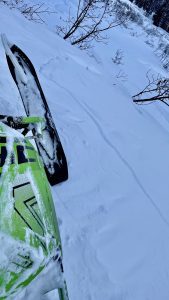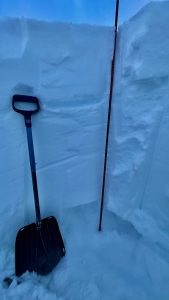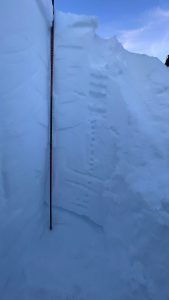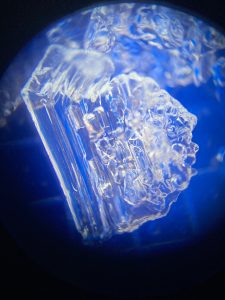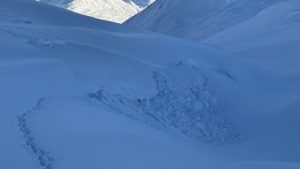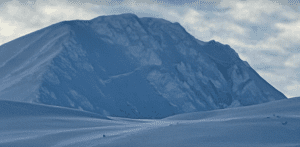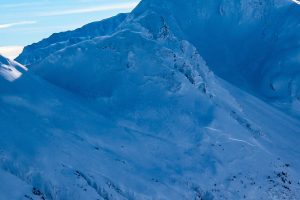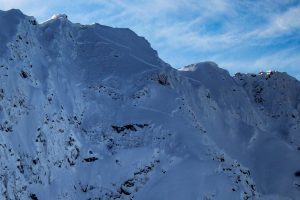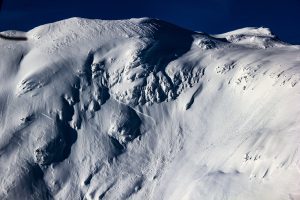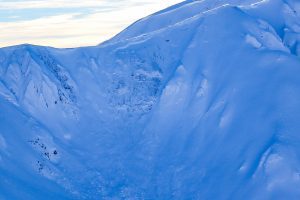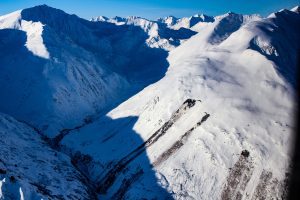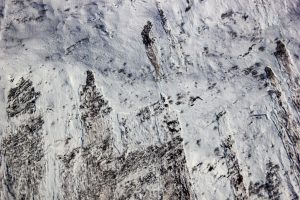Haines Avalanche Center
Above 2,500ftConsiderable
1,500 to 2,500ftModerate
Below 1,500ftModerate
Degrees of Avalanche Danger
Avalanche Problems
Problem 1
The Bottom Line: Fresh snow is available for transport by forecasted SE winds. Lingering wind slabs could also still be reactive. N NE and NW slopes may be harboring windslabs, there are cornices building on ridges, and gullies/ other terrain features maybe cross loaded. The poor structure is widespread, additional stress from this weeks snow has being added, don’t be the trigger that tips the scale. Control what you can: human factor and terrain.
Cold fluffy snow is beautiful and fun, but can also produce dry-loose and slough. Keep this in check.
Terrain management is critical! Be prepared for an avalanche that could step down to deeper instabilities, creating a slide that could break very wide, and take out all the “safe” zones on a slope. Be extra careful not to group up in places that an avalanche can reach. Be diligent and patient, practice good group management, communication and decision making. Do not ski/ride on the same slope as another group. Travel one at a time or with enough spacing so that only one person is exposed to an avalanche path at any one time.
Likelihood:
- Almost Certain
- Very Likely
- Likely
- Possible
- Unlikely
Size:
- Historic
- Very Large
- Large
- Small
Trend
- Increasing
- Steady
- Decreasing
Problem 2
Protected means preserved. When seeking out wind protected zone, remember that wind-protected pockets may be harboring these dangerous weak layers.
Buried Surface Hoar Layers:
- Jan 25th melt freeze crust is about 1-2 feet deep (with recent winds and snow, there is a lot of variability on depth of this widespread layer) sitting on top of it are near surface facets, and buried surface hoar from Feb 1-4.
- January 10th surface hoar is now buried about 3-4 feet deep.
Feb 10 Flower tree-line small wind slab shooting crack on isolated feature.
Feb 10 Flower tree-line 2600′ N NE aspect ECTX. Found Jan 25 melt freeze/facet sandwich ~2’ down from surface. Also noted a thin layer of rounding facets in the mid pack and a thick layer of depth hoar.
Likelihood:
- Almost Certain
- Very Likely
- Likely
- Possible
- Unlikely
Size:
- Historic
- Very Large
- Large
- Small
Trend
- Increasing
- Steady
- Decreasing
Problem 3
Old Melt Layers and Crusts:
- Dec 31 surface hoar layer is present in the Transitional and Pass zones, about 5 ft deep. This layer has been active in pits, and caused some natural avalanches in early January.
- A buried persistent weak layer about 7+ feet deep (The “Big Warmup” Layer, Formed Nov 17th) is still a concern. Numerous natural avalanches observed 1/27 likely on this layer.
- A wide safety margin is necessary. This setup could produce avalanches that break wider than expected, and are most likely to be triggered from shallow trigger points like rocks or small trees. You could ride the same slope numerous times until that right spot produces a large destructive slide.
“Big Warmup” facet layer in the Transitional Zone at 2500ft on Jan 2 with test results ECTP18 that demonstrated propagation potential on this layer.
Pit at Old Faithful, 2500’, East aspect on Jan 12. A 5″ thick layer of facets down 170cm. Also, observation noted faceted surface conditions.
Depth Hoar at the Ground (Above 3,000′):
- October snow followed by long cold snaps created depth hoar at the ground in most areas.
- You are most likely to human-trigger this layer from shallow spots around rocks, or trees, or have a surface avalanche step down to the ground on this layer. Any slides that break to the ground are likely to be deadly.
Photos shows 6-9mm advanced depth hoar at the ground down 180cm with ECTP 25 down 80cm on facets below a crust in the Haines Pass Zone at 4,000ft on a NE-aspect.
Likelihood:
- Almost Certain
- Very Likely
- Likely
- Possible
- Unlikely
Size:
- Historic
- Very Large
- Large
- Small
Trend
- Increasing
- Steady
- Decreasing
Avalanche Activity
Feb 9th: Glide cracks observed ~3000-3400′ in the transitional zone on N, NE aspects. Also notable was observation of reloading of bed surfaces on previous slides.
January 25-29th:
Isolated fresh D2 wind slab avalanches in cross-loaded gullies near the Little Jarvis/Klehini area.
Reports of two snowmachine-triggered slides at the Pass, one was this D2 up West Nadahini Creek above 4,000′ failed 2-7′ deep on an isolated terrain feature. (likely slid on buried surface hoar)
Recent Natural activity
R4D2.5 at the Pass, likely ran on buried surface Hoar, stepped down to depth hoar at ground. Photo by David Morisette, via MIN.
D3 NE aspect 6000′ near Nadahini with widespread propagation.
D3 cycle between 3000-6000ft. All aspects. Most were unsupported slopes or rocky areas. Crowns 1-3m deep, ran just above ground.
Multiple D2 that ran about 2ft deep. In wind protected areas.
2000-3000ft widespread full depth wet slabs and glide avys, all aspects.
D2 N aspect 4300ft sub bowl of Old Faithful failed down to near ground, confined to a smaller pocket.
D3 on SW aspect at Lutak Inlet, ran down to the water
D4 on Takhin Ridge
Weather
Forecast:
Overcast with light snow throughout the day, accumulation 1-2 inches. Temps in the 20s. Light SE winds moderate gusts.
Recent Weather Summary:
- Feb 12 freezing levels 1250ft
- Incremental snow (more in Lutak zone) since Feb 5th, periods of moderate south winds
- Feb 1-4 Near surface facets on top of crust from Jan 25 warm-up
- Jan 17-26 brought around 5″ of precip (3-5 feet of new snow above 3000ft), strong SE winds, and a noticeable warmup
- Surface Hoar and Near Surface Facet growth Jan 8-10
- A strong front brought 24-30″ of snow above 2000ft on Jan 2nd.
- There was widespread Surface Hoar growth on Dec 31st.
- Dec 23-26 brought 10-18″ of new snow and a sharp rise in temperatures from -10F to 30F along with variable winds
- Dec 16-23 brought strong NW winds and arctic cold temperatures
- Dec 15 brought warmth/light rain up to 2600ft
Complete Season Histories: Transitional Zone Lutak Zone
Additional Information
WEAR A HELMET! Be careful of rocks and hidden hazards. Be prepared for crevasses when on a glacier.
Are your riding companions trained and practiced in avalanche rescue? Everyone in your group needs to have a beacon, shovel, and probe, and know how to use them. Our mountains have very limited cell coverage, carry an emergency communication device and enough gear to spend the night.
Avalanche Canada’s Daily Process Flow – Utilize this everyday you go out in the mountains.
Announcements
Click the +Full Forecast link below for each zone to read more. If you see any recent natural avalanche activity, or signs of instability please submit an observation.

